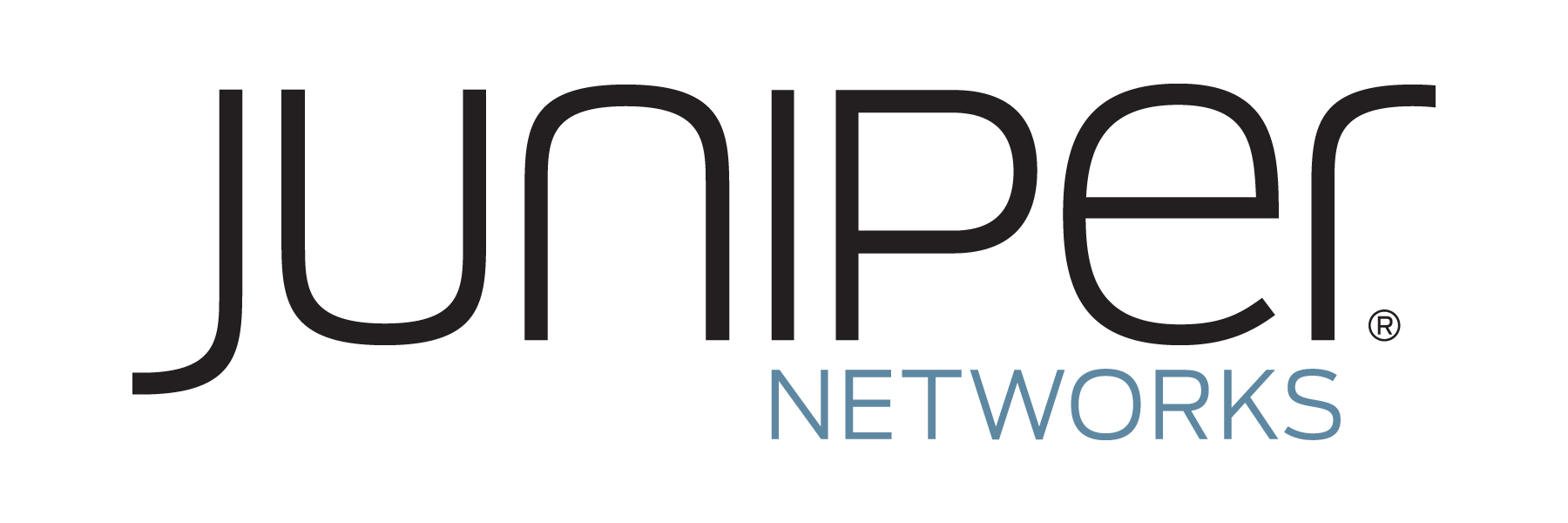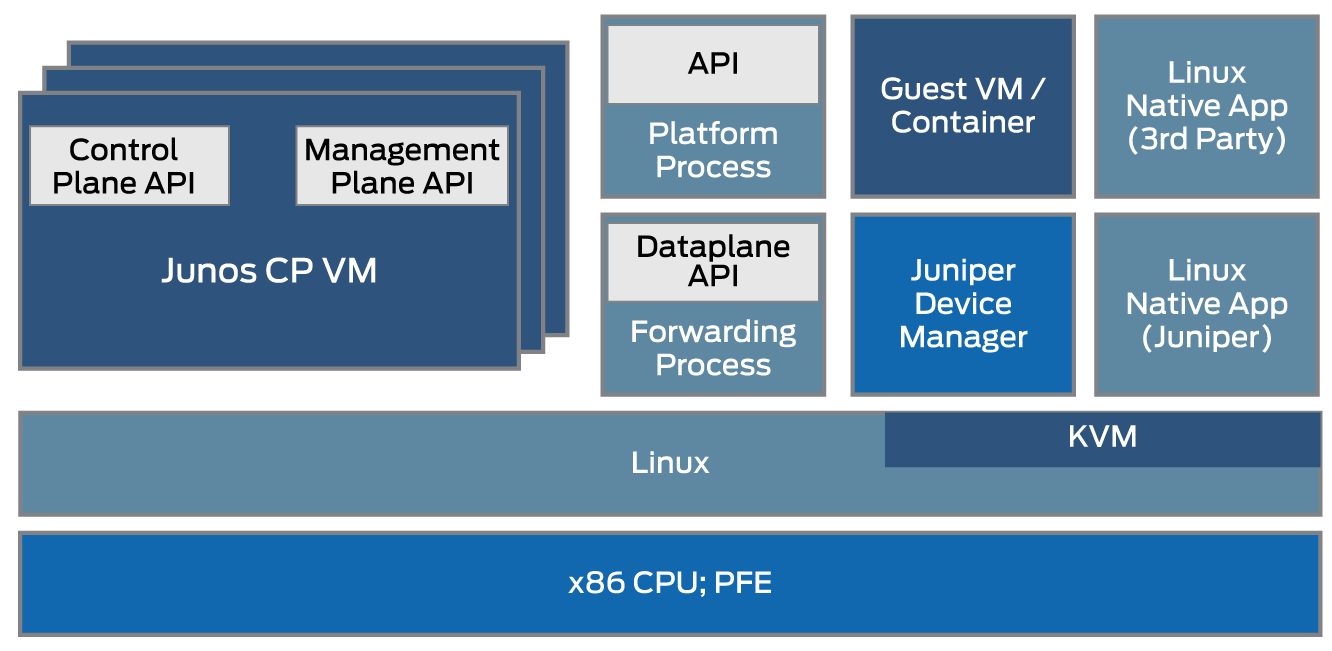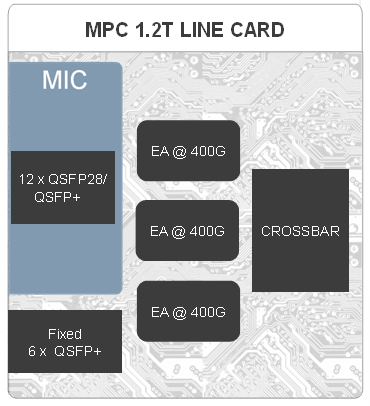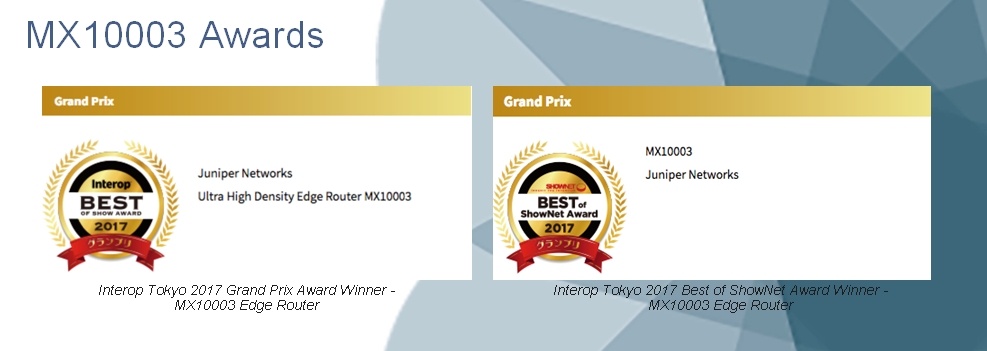New Juniper MX Series Routers
This article discusses three models that represent an update to the Juniper MX Series multiservice routers model line — the MX150, MX10003, and MX204. They are designed primarily for service providers and cover almost the entire range of requirements for devices operating in modern cloud solutions.

1. MX150 3D Universal Edge Router
The MX150 is a high-performance router for low bandwidth applications.
')

Appearance MX150 (front side)
The compact MX150 is a high-performance, multi-functional 40 Gb / s edge router that is ideal for high-bandwidth applications not required by a service provider, distributed service architecture, or enterprises using a WAN.
The device supports 10/100/1000 and 10GbE interfaces, as well as a number of integrated services, including IPsec. Structurally, everything is mounted in a single 1U rack. Thus, the MX150 occupies a minimum of rack space and reduces the costs associated with the consumed electrical power and cooling.
The MX150 runs on the Junos OS network operating system on the virtualized Trio (vTrio) programmable chipset. Together they provide the router with the capabilities of such world-class devices in an economical design.
Junos OS
Junos OS is a modern, full-fledged network operating system that covers routing, switching, and security — in both physical and virtual devices.

Junos OS base architecture
The main characteristics of Junos OS are simplicity and innovation. This is the only OS that provides all of the products included in Juniper’s extensive portfolio and their security.
Junos OS has been improved for more than 20 years, increasing the reliability, security and flexibility of the kernel. It manages some of the most complex network deployments in the world, giving operators a competitive advantage over other network operating systems.
Junos OS automates network operations with high accuracy, guarantees operational efficiency and frees up users time and resources.
Junos OS in data centers
On Junos OS data center platforms, disconnected and running in a virtualized Linux environment. Container-based applications and other guest virtualized operating systems can coexist on the same set of hardware and CPU.
Such systems provide a secure Linux environment for system interoperability and an open platform for integrating third-party applications. The low-level API improves telemetry and programming features. The API also greatly improves access to control and management, providing a high level of automation.
Junos OS Features
For a detailed description of Junos OS, see here . For a description and specifications of the Trio chipset, see here .
Junos OS and vTrio support also ensure operational continuity with the entire MX Series product portfolio, including full support for Junos Automation Toolkit and Juniper Extension Toolkit. In addition to automatically supporting 10/100/1000 and 10GbE interfaces, compact design and low power consumption, the MX150 is characterized by a high level of automation.
Other features of the MX150 include integrated IPsec, which enables the use of secure VPN services, as well as a high level of router management and scalability.
MX150 Design and Specifications

Connectors and indicator located on the front of the MX150

MX150 Key Features
2. MX10003 3D Universal Edge Router
Juniper gives this device the following characteristic - "ultra-high efficiency and density in the ultra-efficient form factor."
The service oriented router MX10003 is a cloud-era edge device. It is optimized for rack space and consumed electrical power. Its purpose is to help service providers and cloud operators who provide customers with long-term traffic, subscription and further expansion of the range of services.
The MX10003 occupies only three stanchions. Its capacity is 4.8 TB / s. The router supports up to 144 10GbE connections, and also has 36 40GbE ports (or 24 100GbE) in a single chassis.
The high efficiency and density of the device make it an ideal choice for a wide range of applications in the following areas:
- provision of business services
- provision of network services at the place of residence of household consumers
- provision of mobile and cloud applications, including
- business VPN
- new generation broadband multiplayer
- consumption of a large amount of Internet traffic
- metro-Ethernet services
- connection with data centers
In addition, the MX10003 supports smart timing, MACsec encryption, a high level of automation and telemetry capabilities. These properties, in fact, lay the foundation for the construction and effective use of autonomous networks.
The MX10003 also provides a high level of network accessibility with “resilience” features that include redundancy of control systems and power supply modules according to the N + 1 scheme.
In addition, the Virtual Chassis technology supports chassis level redundancy, allowing users to manage two routers as a single element. The combination of Junos OS with redundant architecture ensures uninterrupted delivery of services to the client in any network conditions.
MX10003 has MEF CE2.0 Certification for services based on E-Line (100GbE), E-LAN (10GbE), E-Tree (10GbE) and E-Access (100GbE).

View MX10003 from the front and back
Main characteristics
Density - 1,2T per slot
Modularity - Multi-rate 1GE / 10GE / 40GE / 100GE with MACSec Option
Technologies - 3D Memory, TRIO 3rd Gen, Microcode driven
Deployment - Service Edge, Peering, Metro, Colo / Data Center
Software features - rich set of queuing options
Compact design
- Modular platform, 2 Line Card 3RU slots
- Standard 19 ”rack, 760 mm deep.
X86 Based Routing Engine
- Modular, redundant and upgradeable multi-core x86 router engine (Routing Engine).
Power supply
- Power consumption ~ 0.9W / G
- AC / DC PSMs with N + N redundancy
Cooling and NEBS
- Excess cooling throughout the body
- Compatible with NEBS standard
NEBS standard
The NEBS standard was developed by Bell Labs in the 1970s to standardize equipment to be installed in all offices of the company. His goal was to facilitate the design of standard equipment. This should have resulted in lower costs for developing and deploying new devices on the network.
Later, the four largest US telecoms (AT & T, Verizon, BellSouth and Qwest) created the Telecommunications Carrier Group (TCG), a group formed to synchronize the NEBS standards across the entire industry of the country. The tasks of adhering to the NEBS criteria are ensuring the safety of personnel, protecting the property owner of the equipment and operational continuity.
Although the NEBS standards are focused on the US telecommunications environment, they are mainly based on national / international standards and FCC requirements. In particular, the thermal criteria of the NEBS standard require the equipment to operate in certain temperature and humidity ranges, and resume its work after returning to the specified ranges. In addition to thermal requirements, the NEBS standard also contains various physical and electrical criteria.
MX10003 Modular Line Card Specifications
- 1.2T per slot; upgrade to 6.4T per slot is possible
- Ports 100GE, 40GE and 10GE ports
- 12x100GE, 18x40GE or 72x10GE per line card
- 12x100GE MACSec MIC support
- Full HQoS and L4-L7 service

Line Card Connection Diagram
Typical application MX10003
Business edge
- L2 / L3 VPN, VPLS, enhanced VPN support
- A rich set of IP / MPLS features
Metro Ethernet
- Complete set of routing and switching properties
- Supports OAM properties and MEF certification
Data center
- High density 10GbE / 100GbE interfaces
- L2 / L3 VPN, MPLS-over-GRE, VXLAN, GRE support
Ip peering
- Supports IP Peering and route reflection capabilities
- Traffic monitoring, segment routing, BGP, GRE
Distributed BNG
- Supports Broadband Network Gateway (BNG) features with current MX Series routers
BNG technology
Modern broadband network gateways (BNG) should have the technical characteristics and advantages by which network operators will improve the speed of their services, and. as a result, market share and profitability.
Juniper BNG, based on MX Series 3D Universal Edge Routers and Junos OS, helps broadband operators achieve their goals, providing service flexibility, optimal subscription density, and a high level of automation.
The MX Series portfolio includes physical and virtual routing platforms with bandwidths of up to 80 Tbps, which are flexibly integrated into both the centralized and distributed BNG architecture. MX Series routers help you maximize your network investment.
An addition to the Juniper BNG solution is a large variety of border network services for cloud cloud networking and harmonization with the Junos Space Network Management Platform. Junos Space is a centralized tool for monitoring and controlling the entire broadband environment through a single “pane of glass”.

Interop Tokyo is one of the largest and most prestigious computer exhibitions in Asia. Within its framework, a group of experts selects the most innovative products, solutions and services from hundreds of manufacturers from around the world. This year, the MX10003, as a cloud-scale border router, received two main awards in the Career / ISP Networking Division section - Grand Prix and Best of ShowNet.
3. MX204 3D Universal Edge Router
The release is scheduled for the second half of 2017. The router provides a high density of 10GbE / 100GbE in a compact form factor optimized for rack space and consumed electrical power.
The MX204 is fully ready for use in SDN solutions. It is actually a cloud scale platform that offers customers ultra high bandwidth.
The MX204 is designed to work at the edge of the network and on Metro Ethernet, for service providers, mobile operators on the Web, as well as for MSO. It has a bandwidth of 800 Gb / s and supports 10GbE, 40GbE and 100GbE interfaces - all in one rack.
Powered by Junos OS and Trio Programmable Chipset, the MX204 supports a full suite of routing, switching, security and support services that are available on large MX Series platforms - including support for automation and telemetry that serve as the basis for future generations of the Self-Driving Network (SDN).
Additionally, the MX204 supports strict timing and synchronization requirements for mobile and financial services.

Appearance, connectors and MX204 devices (front and back)
Main characteristics
Compact design
- Form factor 1RU
- Standard 19 ”rack, 515 mm deep (compatible with ETSI 600)
- Bandwidth 400G
- 4x100GE, 4x40GE and 24 10 / 1GE ports
- Full support for HQoS, 1588, SyncE
X86 Based Routing Engine
- Modular, redundant and upgradeable multi-core x86 router engine (Routing Engine).
Power supply
- Power consumption ~ 0.9W / G
- AC / DC PSMs with N + N redundancy
Cooling and NEBS
- Excess cooling throughout the body
- Compatible with NEBS standard

1. MX150 3D Universal Edge Router
The MX150 is a high-performance router for low bandwidth applications.
')

Appearance MX150 (front side)
The compact MX150 is a high-performance, multi-functional 40 Gb / s edge router that is ideal for high-bandwidth applications not required by a service provider, distributed service architecture, or enterprises using a WAN.
The device supports 10/100/1000 and 10GbE interfaces, as well as a number of integrated services, including IPsec. Structurally, everything is mounted in a single 1U rack. Thus, the MX150 occupies a minimum of rack space and reduces the costs associated with the consumed electrical power and cooling.
The MX150 runs on the Junos OS network operating system on the virtualized Trio (vTrio) programmable chipset. Together they provide the router with the capabilities of such world-class devices in an economical design.
Junos OS
Junos OS is a modern, full-fledged network operating system that covers routing, switching, and security — in both physical and virtual devices.

Junos OS base architecture
The main characteristics of Junos OS are simplicity and innovation. This is the only OS that provides all of the products included in Juniper’s extensive portfolio and their security.
Junos OS has been improved for more than 20 years, increasing the reliability, security and flexibility of the kernel. It manages some of the most complex network deployments in the world, giving operators a competitive advantage over other network operating systems.
Junos OS automates network operations with high accuracy, guarantees operational efficiency and frees up users time and resources.
Junos OS in data centers
On Junos OS data center platforms, disconnected and running in a virtualized Linux environment. Container-based applications and other guest virtualized operating systems can coexist on the same set of hardware and CPU.
Such systems provide a secure Linux environment for system interoperability and an open platform for integrating third-party applications. The low-level API improves telemetry and programming features. The API also greatly improves access to control and management, providing a high level of automation.
Junos OS Features
- Open and programmable automation provides a DevOps approach that simplifies complex network operations and increases service flexibility.
- Disaggregation of the OS provides low-level access to programmable interfaces and application environments on data center platforms.
- Convergence is to combine parallel networks that run on a single chassis using Junos Node Slicing technology to optimize the network infrastructure and speed up service deployment.
- High availability provides installation and change of additional equipment (Line Cards), as well as updating the OS without the need to involve branded customer support.
- Simple management of routing rules supports traffic management in fine-grained networks, while separate monitoring and control improves reliability and security.
For a detailed description of Junos OS, see here . For a description and specifications of the Trio chipset, see here .
Junos OS and vTrio support also ensure operational continuity with the entire MX Series product portfolio, including full support for Junos Automation Toolkit and Juniper Extension Toolkit. In addition to automatically supporting 10/100/1000 and 10GbE interfaces, compact design and low power consumption, the MX150 is characterized by a high level of automation.
Other features of the MX150 include integrated IPsec, which enables the use of secure VPN services, as well as a high level of router management and scalability.
MX150 Design and Specifications

Connectors and indicator located on the front of the MX150

MX150 Key Features
2. MX10003 3D Universal Edge Router
Juniper gives this device the following characteristic - "ultra-high efficiency and density in the ultra-efficient form factor."
The service oriented router MX10003 is a cloud-era edge device. It is optimized for rack space and consumed electrical power. Its purpose is to help service providers and cloud operators who provide customers with long-term traffic, subscription and further expansion of the range of services.
The MX10003 occupies only three stanchions. Its capacity is 4.8 TB / s. The router supports up to 144 10GbE connections, and also has 36 40GbE ports (or 24 100GbE) in a single chassis.
The high efficiency and density of the device make it an ideal choice for a wide range of applications in the following areas:
- provision of business services
- provision of network services at the place of residence of household consumers
- provision of mobile and cloud applications, including
- business VPN
- new generation broadband multiplayer
- consumption of a large amount of Internet traffic
- metro-Ethernet services
- connection with data centers
In addition, the MX10003 supports smart timing, MACsec encryption, a high level of automation and telemetry capabilities. These properties, in fact, lay the foundation for the construction and effective use of autonomous networks.
The MX10003 also provides a high level of network accessibility with “resilience” features that include redundancy of control systems and power supply modules according to the N + 1 scheme.
In addition, the Virtual Chassis technology supports chassis level redundancy, allowing users to manage two routers as a single element. The combination of Junos OS with redundant architecture ensures uninterrupted delivery of services to the client in any network conditions.
MX10003 has MEF CE2.0 Certification for services based on E-Line (100GbE), E-LAN (10GbE), E-Tree (10GbE) and E-Access (100GbE).

View MX10003 from the front and back
Main characteristics
Density - 1,2T per slot
Modularity - Multi-rate 1GE / 10GE / 40GE / 100GE with MACSec Option
Technologies - 3D Memory, TRIO 3rd Gen, Microcode driven
Deployment - Service Edge, Peering, Metro, Colo / Data Center
Software features - rich set of queuing options
Compact design
- Modular platform, 2 Line Card 3RU slots
- Standard 19 ”rack, 760 mm deep.
X86 Based Routing Engine
- Modular, redundant and upgradeable multi-core x86 router engine (Routing Engine).
Power supply
- Power consumption ~ 0.9W / G
- AC / DC PSMs with N + N redundancy
Cooling and NEBS
- Excess cooling throughout the body
- Compatible with NEBS standard
NEBS standard
The NEBS standard was developed by Bell Labs in the 1970s to standardize equipment to be installed in all offices of the company. His goal was to facilitate the design of standard equipment. This should have resulted in lower costs for developing and deploying new devices on the network.
Later, the four largest US telecoms (AT & T, Verizon, BellSouth and Qwest) created the Telecommunications Carrier Group (TCG), a group formed to synchronize the NEBS standards across the entire industry of the country. The tasks of adhering to the NEBS criteria are ensuring the safety of personnel, protecting the property owner of the equipment and operational continuity.
Although the NEBS standards are focused on the US telecommunications environment, they are mainly based on national / international standards and FCC requirements. In particular, the thermal criteria of the NEBS standard require the equipment to operate in certain temperature and humidity ranges, and resume its work after returning to the specified ranges. In addition to thermal requirements, the NEBS standard also contains various physical and electrical criteria.
MX10003 Modular Line Card Specifications
- 1.2T per slot; upgrade to 6.4T per slot is possible
- Ports 100GE, 40GE and 10GE ports
- 12x100GE, 18x40GE or 72x10GE per line card
- 12x100GE MACSec MIC support
- Full HQoS and L4-L7 service

Line Card Connection Diagram
Typical application MX10003
Business edge
- L2 / L3 VPN, VPLS, enhanced VPN support
- A rich set of IP / MPLS features
Metro Ethernet
- Complete set of routing and switching properties
- Supports OAM properties and MEF certification
Data center
- High density 10GbE / 100GbE interfaces
- L2 / L3 VPN, MPLS-over-GRE, VXLAN, GRE support
Ip peering
- Supports IP Peering and route reflection capabilities
- Traffic monitoring, segment routing, BGP, GRE
Distributed BNG
- Supports Broadband Network Gateway (BNG) features with current MX Series routers
BNG technology
Modern broadband network gateways (BNG) should have the technical characteristics and advantages by which network operators will improve the speed of their services, and. as a result, market share and profitability.
Juniper BNG, based on MX Series 3D Universal Edge Routers and Junos OS, helps broadband operators achieve their goals, providing service flexibility, optimal subscription density, and a high level of automation.
The MX Series portfolio includes physical and virtual routing platforms with bandwidths of up to 80 Tbps, which are flexibly integrated into both the centralized and distributed BNG architecture. MX Series routers help you maximize your network investment.
An addition to the Juniper BNG solution is a large variety of border network services for cloud cloud networking and harmonization with the Junos Space Network Management Platform. Junos Space is a centralized tool for monitoring and controlling the entire broadband environment through a single “pane of glass”.

Interop Tokyo is one of the largest and most prestigious computer exhibitions in Asia. Within its framework, a group of experts selects the most innovative products, solutions and services from hundreds of manufacturers from around the world. This year, the MX10003, as a cloud-scale border router, received two main awards in the Career / ISP Networking Division section - Grand Prix and Best of ShowNet.
3. MX204 3D Universal Edge Router
The release is scheduled for the second half of 2017. The router provides a high density of 10GbE / 100GbE in a compact form factor optimized for rack space and consumed electrical power.
The MX204 is fully ready for use in SDN solutions. It is actually a cloud scale platform that offers customers ultra high bandwidth.
The MX204 is designed to work at the edge of the network and on Metro Ethernet, for service providers, mobile operators on the Web, as well as for MSO. It has a bandwidth of 800 Gb / s and supports 10GbE, 40GbE and 100GbE interfaces - all in one rack.
Powered by Junos OS and Trio Programmable Chipset, the MX204 supports a full suite of routing, switching, security and support services that are available on large MX Series platforms - including support for automation and telemetry that serve as the basis for future generations of the Self-Driving Network (SDN).
Additionally, the MX204 supports strict timing and synchronization requirements for mobile and financial services.

Appearance, connectors and MX204 devices (front and back)
Main characteristics
Compact design
- Form factor 1RU
- Standard 19 ”rack, 515 mm deep (compatible with ETSI 600)
- Bandwidth 400G
- 4x100GE, 4x40GE and 24 10 / 1GE ports
- Full support for HQoS, 1588, SyncE
X86 Based Routing Engine
- Modular, redundant and upgradeable multi-core x86 router engine (Routing Engine).
Power supply
- Power consumption ~ 0.9W / G
- AC / DC PSMs with N + N redundancy
Cooling and NEBS
- Excess cooling throughout the body
- Compatible with NEBS standard
Source: https://habr.com/ru/post/342902/
All Articles